- The 10-stamp set features marvels of British engineering from the last 50 years
- From the smallest of computers, the Raspberry Pi, to the Falkirk Wheel, the world’s only rotating boat lift, Britain has a long and proud history of engineering
- Also included are: the three-way catalytic converter; superconducting magnets and the monumental tunnel boring project that will enable Crossrail
- Completing the main six-stamp set is the synthetic bone-graft devised by Dr Karin Hing at Queen Mary University of London
- Also featured is the Harrier Jump Jet, celebrating 50 years since it entered RAF service. Four stamps, presented in a Miniature Sheet, show the first operational jet fighter in the world to use revolutionary vertical short take-off and landing technology
- Royal Mail worked with the Royal Academy of Engineering on the stamp set
- The stamps and a range of collectible products are available from www.royalmail.com/britishengineering, by phone on 03457 641 641 and in 7,000 Post Offices throughout the UK
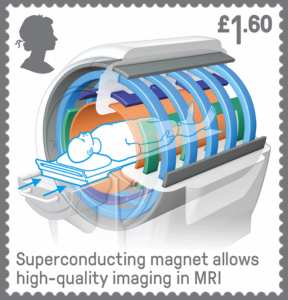 Royal Mail has revealed 10 new Special Stamps to mark Britain’s long and proud history of engineering excellence.
Royal Mail has revealed 10 new Special Stamps to mark Britain’s long and proud history of engineering excellence.
World-class inventions and innovations have had a huge impact on many aspects of modern life, from medicine and computing to travel and infrastructure. The last 50 years have produced many marvels of British engineering, from the smallest of computers, the Raspberry Pi, to the Falkirk Wheel, the world’s only rotating boat lift.
At just the size of a credit card, the Raspberry Pi might be tiny, but with sales of over 20 million these microcomputers have revolutionised education in computer science and programming worldwide.
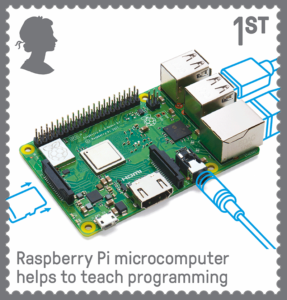 A collaboration of British engineers and architects produced the world’s first and only rotating boat lift, The Falkirk Wheel, joining two major Scottish canals for the first time in 70 years with a phenomenally beautiful structure.
A collaboration of British engineers and architects produced the world’s first and only rotating boat lift, The Falkirk Wheel, joining two major Scottish canals for the first time in 70 years with a phenomenally beautiful structure.
Today cars are far less polluting than they were 50 years ago, due to three-way catalytic converters scrubbing car exhausts of harmful gases.
Chris Morgan, Technology Director at Johnson Matthey, commented: “Being recognised with a stamp celebrating British Engineering is a huge honour for employees past and present who have been involved in Johnson Matthey’s ground-breaking work behind the Catalytic Converter. Every year, our catalytic converters 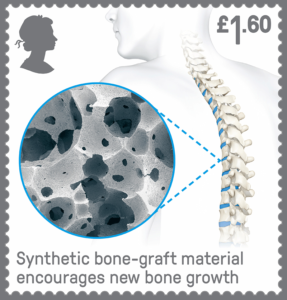 prevent some 20 million tonnes of pollutants from entering the atmosphere, helping to make the world cleaner and healthier.”
prevent some 20 million tonnes of pollutants from entering the atmosphere, helping to make the world cleaner and healthier.”
MRI scanners, on which we now rely for routine imaging of our bodies, would not be possible without the work done with superconducting magnets by British engineers at Oxford Instruments.
The monumental tunnel boring project that will enable Crossrail, required 13 miles (21km) of twin tunnels under the city, and navigated existing sewers, Tube train tunnels and building foundations.
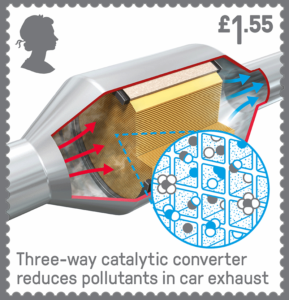 The team at Queen Mary University of London led by Dr Karin Hing, engineered materials that encourage bone growth when used in complex orthopaedic surgeries and have improved the outcomes for hundreds of thousands of patients worldwide.
The team at Queen Mary University of London led by Dr Karin Hing, engineered materials that encourage bone growth when used in complex orthopaedic surgeries and have improved the outcomes for hundreds of thousands of patients worldwide.
Dr Karin Hing said: “It was a delightful surprise and a huge honour for my work on synthetic bone grafts to be recognised with a stamp and, in particular, to be part of a set which celebrates some incredible innovations in British engineering. I feel very fortunate that my research has gone on to have such a positive impact on 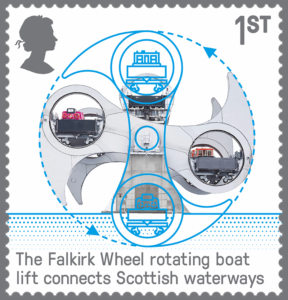 people’s lives, but this would not have been possible without multidisciplinary collaboration. Having our engineering of synthetic bone grafts celebrated on a stamp like the Marvel Comics and the Harry Potter books might even impress my kids.”
people’s lives, but this would not have been possible without multidisciplinary collaboration. Having our engineering of synthetic bone grafts celebrated on a stamp like the Marvel Comics and the Harry Potter books might even impress my kids.”
Completing the issue, is another of the UK’s many success stories – the Harrier Jump Jet, designed and produced by Hawker Siddeley, which entered service with the RAF 50 years ago. It remains one of the few operational aircraft capable of vertical take-off and landing. More advanced Harriers developed by British Aerospace (later BAE Systems) and McDonnell Douglas (later Boeing) were used by the militaries of a number of countries. 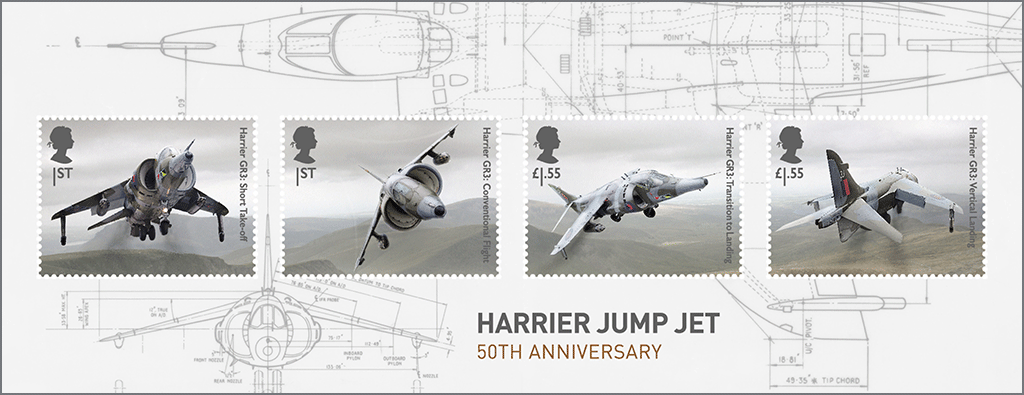
This cross-section of engineering marvels showcases the ingenuity of engineers working in the UK.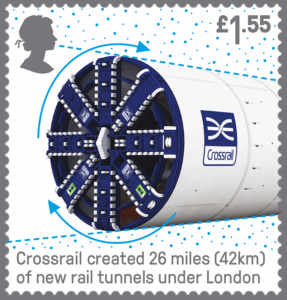 Some of the innovations celebrated have won the MacRobert Award, bestowed by the Royal Academy of Engineering – the UK’s most prestigious and longest running award for engineering excellence. The award marks its 50th birthday this year.Dr Dame Sue Ion DBE FREng FRS, Chair of Judges for the Royal Academy of Engineering MacRobert Award, said: “The UK is a global engineering powerhouse with many world firsts developed here that have both benefitted our economy and helped to transform people’s lives for the better. This wonderful new set of Royal Mail stamps perfectly encapsulates the technical and commercial achievements made by British engineers over the last 50 years, from the Harrier jump jet to Raspberry Pi. These great British engineering innovations – several of which have won the MacRobert Award, the UK’s biggest prize for engineering innovation – represent an amazing foundation from which to develop exciting technologies for the future.”Philip Parker, Royal Mail, said: “British innovation in engineering is world renowned. This stamp issue proudly celebrates the projects and inventions which showcase this, as well as demonstrating the extraordinary range of disciplines that British engineers excel in.”
Some of the innovations celebrated have won the MacRobert Award, bestowed by the Royal Academy of Engineering – the UK’s most prestigious and longest running award for engineering excellence. The award marks its 50th birthday this year.Dr Dame Sue Ion DBE FREng FRS, Chair of Judges for the Royal Academy of Engineering MacRobert Award, said: “The UK is a global engineering powerhouse with many world firsts developed here that have both benefitted our economy and helped to transform people’s lives for the better. This wonderful new set of Royal Mail stamps perfectly encapsulates the technical and commercial achievements made by British engineers over the last 50 years, from the Harrier jump jet to Raspberry Pi. These great British engineering innovations – several of which have won the MacRobert Award, the UK’s biggest prize for engineering innovation – represent an amazing foundation from which to develop exciting technologies for the future.”Philip Parker, Royal Mail, said: “British innovation in engineering is world renowned. This stamp issue proudly celebrates the projects and inventions which showcase this, as well as demonstrating the extraordinary range of disciplines that British engineers excel in.”
Raspberry Pi
The Raspberry Pi has sparked a worldwide revolution in low-cost computing. At the size of a credit card and with prices starting at £5, these award-winning  microcomputers pack a mighty punch. Since February 2012, over 20 million have been sold, making the Raspberry Pi Britain’s bestselling computer. The beauty of this ingenious microcomputer lies in its versatility. The device features USB ports, onboard memory, video output, audio output and Internet connectivity. Its general purpose input/output connectors allow for other capabilities, such as sensors and actuators, to be hooked up to its tiny processors, so that the only limit is the user’s imagination. From a Sony factory in South Wales, Raspberry Pis have reached all corners of the globe and even gone into space.
microcomputers pack a mighty punch. Since February 2012, over 20 million have been sold, making the Raspberry Pi Britain’s bestselling computer. The beauty of this ingenious microcomputer lies in its versatility. The device features USB ports, onboard memory, video output, audio output and Internet connectivity. Its general purpose input/output connectors allow for other capabilities, such as sensors and actuators, to be hooked up to its tiny processors, so that the only limit is the user’s imagination. From a Sony factory in South Wales, Raspberry Pis have reached all corners of the globe and even gone into space.
The Raspberry Pi Foundation is a charitable company working to overhaul how computing is taught in schools. It offers free learning resources on its website, as well as supporting teacher training courses and over 10,000 code clubs across the world to encourage young people to experiment with computer science. Although the Raspberry Pi was originally intended as an educational resource, the adult maker and hacking communities have also embraced it, and its applications seem endless. From landmine-clearing robots to home irrigation systems, and from heart monitors to experimentation on the International Space Station, the Raspberry Pi has transformed the computing landscape and was awarded the Royal Academy of Engineering’s MacRobert Award in 2017.
The Falkirk Wheel
The Falkirk Wheel is the world’s first and only rotating boat lift, vertically connecting the Forth and Clyde Canal with the Union Canal. The two waterways were once  connected by a series of 11 locks, which took almost a day to traverse, but these were dismantled in 1933. As part of the Millennium Link project, the British Waterways Board teamed up with Arup, Butterley Engineering and RMJM architects to reconnect the canals after 70 years with a 21st-century landmark structure.
connected by a series of 11 locks, which took almost a day to traverse, but these were dismantled in 1933. As part of the Millennium Link project, the British Waterways Board teamed up with Arup, Butterley Engineering and RMJM architects to reconnect the canals after 70 years with a 21st-century landmark structure.
The Union Canal extends out of the countryside via an aqueduct to meet the top of the wheel, which consists of two opposing arms whose design was inspired by a double-headed Celtic axe and a ship’s propeller. On the end of each arm is a water-filled caisson that can hold up to four canal boats, plus enough water to fill an Olympic sized swimming pool. The weight on each arm must be carefully balanced. According to Archimedes’ principle, boats entering the caisson will displace their own weight in water. Therefore, water levels in the caissons are precisely computer controlled, with a tolerance of only 37mm. This equalisation allows ten hydraulic motors to turn the wheel using very little energy – half a turn uses the equivalent of boiling eight kettles to raise boats 35m in just four minutes.
Three-way catalytic converter
Catalytic converters clean the emissions from vehicles that have internal combustion engines. In the early 1980s, British company Johnson Matthey pioneered the three- way catalytic converter. This type is now fitted to petrol-powered vehicles worldwide and the company is a world leader, supplying about a third of these globally. The technology converts toxic pollutants into milder gases, making the air we breathe cleaner and healthier. The three-way catalytic converter turns carbon monoxide, unburnt hydrocarbons and oxides of nitrogen into carbon dioxide, water and nitrogen. It does this with the use of metallic catalysts containing platinum, palladium and rhodium that are coated onto a ceramic honeycomb ‘monolith’ through which the exhaust gases flow. The efficiency of the three simultaneous reactions going on inside the three-way converter relies on a precise ratio of air and fuel in the engine’s injection system.
way catalytic converter. This type is now fitted to petrol-powered vehicles worldwide and the company is a world leader, supplying about a third of these globally. The technology converts toxic pollutants into milder gases, making the air we breathe cleaner and healthier. The three-way catalytic converter turns carbon monoxide, unburnt hydrocarbons and oxides of nitrogen into carbon dioxide, water and nitrogen. It does this with the use of metallic catalysts containing platinum, palladium and rhodium that are coated onto a ceramic honeycomb ‘monolith’ through which the exhaust gases flow. The efficiency of the three simultaneous reactions going on inside the three-way converter relies on a precise ratio of air and fuel in the engine’s injection system.
This important balance is controlled electronically, using constant feedback from oxygen sensors in the exhaust to ensure that the optimum air-to-fuel ratio is being burnt for the most efficient exhaust conversion. This feedback system has a slight lag, so in reality the ratio fluctuates above and below the ideal proportions. A cerium oxide component in the catalyst helps to correct for these fluctuations, allowing the overall emissions of harmful exhaust gases to be massively reduced. Thanks to catalytic converter technologies such as this, today’s passenger vehicles are far less polluting than those of 50 years ago. Johnson Matthey Group was awarded the Royal Academy of Engineering’s MacRobert Award in 1980 for this innovation.
Crossrail
Crossrail is the name of the project that created a new railway line through London, linking Reading and Heathrow Airport in the west with the City and Essex in the east.  The prediction is that once it is up and running, the Elizabeth line (as it was named in 2016) will be used by 200 million passengers annually, increasing the rail capacity of central London by 10 per cent and bringing 1.5 million more people within a 45-minute commute of the city’s key areas. The project represented a monumental engineering challenge, requiring 13 miles (21km) of new twin tunnels to be bored under the city. These had to weave through the existing underground networks of Tube train tunnels, underground stations, sewers and buildings.
The prediction is that once it is up and running, the Elizabeth line (as it was named in 2016) will be used by 200 million passengers annually, increasing the rail capacity of central London by 10 per cent and bringing 1.5 million more people within a 45-minute commute of the city’s key areas. The project represented a monumental engineering challenge, requiring 13 miles (21km) of new twin tunnels to be bored under the city. These had to weave through the existing underground networks of Tube train tunnels, underground stations, sewers and buildings.
At Tottenham Court Road station, the tunnel passed between the Northern line and an escalator tunnel with less than 1m clearance either side, a feat nicknamed ‘the eye of the needle’. Tunnelling was completed in 2015 and was achieved using eight Herrenknecht tunnel boring machines, which excavated and removed 3.4 million tonnes of material. In partnership with the Royal Society for the Protection of Birds (RSPB), 3 million tonnes were moved to Essex to create the Wallasea Island Wild Coast Project.
Superconducting magnet for MRI
Today, magnetic resonance imaging (MRI) is used routinely in hospitals around the world to generate pictures of the insides of our bodies to help diagnose maladies  such as cancer, internal bleeding or infections. This revolutionary, non-invasive technique would not be possible without powerful superconducting magnets, which were first developed in the 1960s and in the 1970s applied to body scanning by Sir Martin Wood of Oxford Instruments. The first electromagnet was invented by British scientist William Sturgeon in 1824, and today’s superconducting magnets are based on the same principles.
such as cancer, internal bleeding or infections. This revolutionary, non-invasive technique would not be possible without powerful superconducting magnets, which were first developed in the 1960s and in the 1970s applied to body scanning by Sir Martin Wood of Oxford Instruments. The first electromagnet was invented by British scientist William Sturgeon in 1824, and today’s superconducting magnets are based on the same principles.
A superconducting magnet is made up of a large coil of wire that, when electricity is passed through it, produces a strong magnetic field thanks to the laws of electromagnetism. The coil itself is made from very thin filaments of a niobium-titanium alloy, which are embedded in a copper matrix. This material becomes superconductive if it is cooled to below ten kelvins (–263ºC). In this state, it has nearly zero electrical resistance and, once created, the magnetic field is self-sustaining – it does not require external power during operation. To achieve these cryogenic temperatures, the superconducting coil is cooled using liquid helium and is insulated from the warmth of its surroundings by a vacuum. In this way, the coils in MRI machines can produce magnetic fields that are around 50,000 times that of the Earth’s magnetic field. The Royal Academy of Engineering awarded Oxford Instruments the MacRobert Prize in 1986 for their work on superconducting magnets.
Synthetic bone-graft substitute
When bones fracture, they are often able to heal themselves. But sometimes the fracture is too large or complex for the body to repair on its own, so bone grafts are  used in surgery to promote bone healing. These grafts can be either taken from the patient’s own body (auto-graft) or engineered (synthetic bone-graft substitute). Whereas an auto-graft introduces a natural template and new living bone cells into the area, a synthetic bone graft must bioactively encourage native bone and stem cells to form new bone tissue, which should eventually replace the synthetic scaffold material completely.
used in surgery to promote bone healing. These grafts can be either taken from the patient’s own body (auto-graft) or engineered (synthetic bone-graft substitute). Whereas an auto-graft introduces a natural template and new living bone cells into the area, a synthetic bone graft must bioactively encourage native bone and stem cells to form new bone tissue, which should eventually replace the synthetic scaffold material completely.
Dr Karin Hing and the team at Queen Mary University of London developed bone-graft substitutes able to enhance the body’s natural ability to rebuild bone tissue by looking at their structure and chemistry. The team studied the sponge-like structure of cancellous bone and mimicked it in the synthetic material. The pores needed to be the right size for new bone to grow into as well as interconnected, to allow for the exchange of nutrients via blood vessels to make and sustain healthy tissue. The group is also investigating the role of the grafts’ chemistry on bone regeneration, where the introduction of silicate ions into the scaffold is believed to alter the surface chemistry so that the right proteins are recruited to direct cell attachment and bone formation. This work resulted in the commercial launch of the bioactive synthetic bone grafts Actifuse™ and Inductigraft™. Dr Hing was awarded the Royal Academy of Engineering’s Silver Medal in 2011 for her work.
Harrier Jump Jet
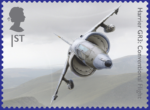 The Hawker Siddeley Harrier was developed from a unique experimental aircraft known as the P 1127, which was capable of taking off and landing vertically. In 1962, British, US and German armed forces procured nine of these aircraft to form a Tri-Partite Evaluation Squadron at RAF West Raynham. Now called Kestrels, these aircraft could take off and land using paved runways, semi-prepared sites in clearings in woods and other confined
The Hawker Siddeley Harrier was developed from a unique experimental aircraft known as the P 1127, which was capable of taking off and landing vertically. In 1962, British, US and German armed forces procured nine of these aircraft to form a Tri-Partite Evaluation Squadron at RAF West Raynham. Now called Kestrels, these aircraft could take off and land using paved runways, semi-prepared sites in clearings in woods and other confined 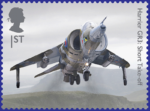 spaces.
spaces.
The success of the trials and the exciting concept of vertical take-off and landing (VTOL), led to the UK Ministry of Defence ordering a batch of the aircraft in 1965. These were the first Harriers, entering RAF service with No. 1 Squadron in April 1969. Over the next 30 years, British Aerospace (later BAE Systems) developed Harriers for 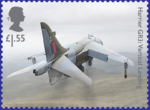 extremely effective ground attack. They could drop precision-guided weapons and operate in poor weather using the latest radar, infrared and optical devices. Because of their remarkable take-off ability, they became known as Harrier Jump Jets.
extremely effective ground attack. They could drop precision-guided weapons and operate in poor weather using the latest radar, infrared and optical devices. Because of their remarkable take-off ability, they became known as Harrier Jump Jets.
Rolls-Royce developed the innovative Pegasus engine of the Harrier, and for this they shared the first MacRobert Award from the Royal  Academy of Engineering in 1969. Photographer Richard Cook captured a Harrier GR3 especially for the stamps.
Academy of Engineering in 1969. Photographer Richard Cook captured a Harrier GR3 especially for the stamps.
The stamps and a range of collectible products are available from www.royalmail.com/britishengineering, by phone on 03457 641 641 and in 7,000 Post Offices throughout the UK.
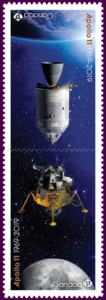 LONGUEUIL, QUE. – Canada Post today issued two commemorative stamps celebrating the 50th anniversary of the historic Apollo 11 mission that landed humans on the moon for the first time – and the Canadians who helped make it possible.
LONGUEUIL, QUE. – Canada Post today issued two commemorative stamps celebrating the 50th anniversary of the historic Apollo 11 mission that landed humans on the moon for the first time – and the Canadians who helped make it possible.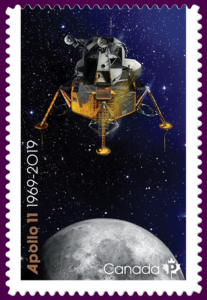 Jim Chamberlin was a leading figure in aircraft design in Canada before moving to the U.S. in 1959 to work for NASA. He became head of engineering for Project Mercury, the first human spaceflight program for the United States, and project manager and chief designer for the Gemini spacecraft that preceded Apollo. He helped determine the type of spacecraft that would transport the Apollo 11 astronauts and was one of the first at NASA to recognize that flying directly to the moon wasn’t the best option. Instead, Chamberlin favoured having a smaller landing module travel to lunar orbit attached to the main spacecraft, then descend to the moon’s surface and later reconnect with the main spacecraft. This approach, known as lunar orbit rendezvous, became fundamental to the Apollo program.
Jim Chamberlin was a leading figure in aircraft design in Canada before moving to the U.S. in 1959 to work for NASA. He became head of engineering for Project Mercury, the first human spaceflight program for the United States, and project manager and chief designer for the Gemini spacecraft that preceded Apollo. He helped determine the type of spacecraft that would transport the Apollo 11 astronauts and was one of the first at NASA to recognize that flying directly to the moon wasn’t the best option. Instead, Chamberlin favoured having a smaller landing module travel to lunar orbit attached to the main spacecraft, then descend to the moon’s surface and later reconnect with the main spacecraft. This approach, known as lunar orbit rendezvous, became fundamental to the Apollo program.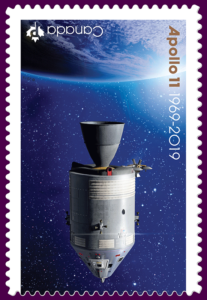 nada’s top aircraft engineers before being hired by NASA in 1959, Owen Maynard went on to head the Systems Engineering Division for the Apollo spacecraft program – effectively making him the chief engineer. He sketched early designs of the main Apollo command module and is credited as the person at NASA most responsible for the design of the lunar lander. He also served as Chief of the Mission Operations Division and was responsible for planning the sequence of missions that led to Apollo 11. Like Chamberlin, Maynard also played an important role in determining the safest way to reach and land on the moon.
nada’s top aircraft engineers before being hired by NASA in 1959, Owen Maynard went on to head the Systems Engineering Division for the Apollo spacecraft program – effectively making him the chief engineer. He sketched early designs of the main Apollo command module and is credited as the person at NASA most responsible for the design of the lunar lander. He also served as Chief of the Mission Operations Division and was responsible for planning the sequence of missions that led to Apollo 11. Like Chamberlin, Maynard also played an important role in determining the safest way to reach and land on the moon.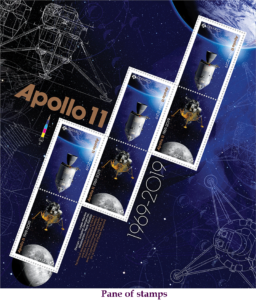 The first legs to stand on the moon didn’t belong to Neil Armstrong – they were from Héroux Machine Parts Limited of Longueuil, Quebec. Now known as Héroux-Devtek, the company manufactured the spider-like landing gear legs on the lunar module to NASA’s specifications. The legs were also part of the launch platform that let Neil Armstrong and Buzz Aldrin lift off from the moon and reconnect with the main command module. Those legs remain on the moon at the Apollo 11 landing site, in an area known as the Sea of Tranquility.
The first legs to stand on the moon didn’t belong to Neil Armstrong – they were from Héroux Machine Parts Limited of Longueuil, Quebec. Now known as Héroux-Devtek, the company manufactured the spider-like landing gear legs on the lunar module to NASA’s specifications. The legs were also part of the launch platform that let Neil Armstrong and Buzz Aldrin lift off from the moon and reconnect with the main command module. Those legs remain on the moon at the Apollo 11 landing site, in an area known as the Sea of Tranquility.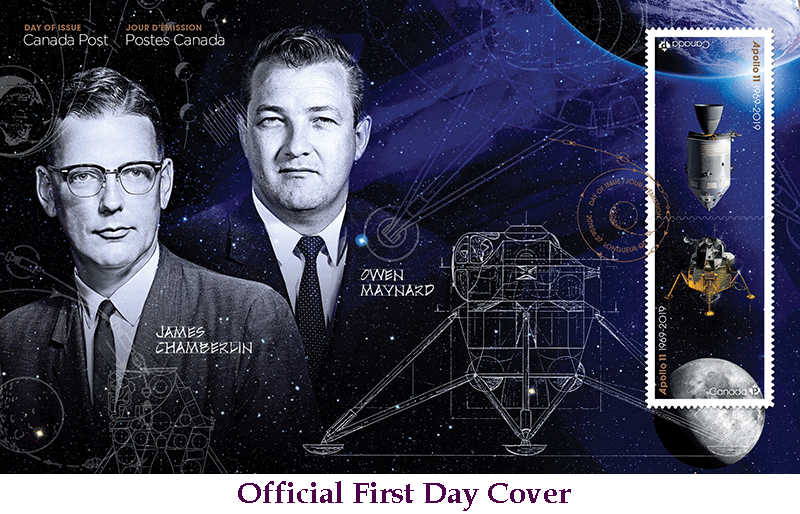
 [en Francais]
[en Francais] LONGUEUIL, QUÉBEC – Aujourd’hui, Postes Canada a émis deux timbres-poste commémoratifs en l’honneur du 50e anniversaire de la mission Apollo 11 et des Canadiens qui ont contribué au succès du moment historique où l’humanité a fait ses premiers pas sur la Lune.
LONGUEUIL, QUÉBEC – Aujourd’hui, Postes Canada a émis deux timbres-poste commémoratifs en l’honneur du 50e anniversaire de la mission Apollo 11 et des Canadiens qui ont contribué au succès du moment historique où l’humanité a fait ses premiers pas sur la Lune.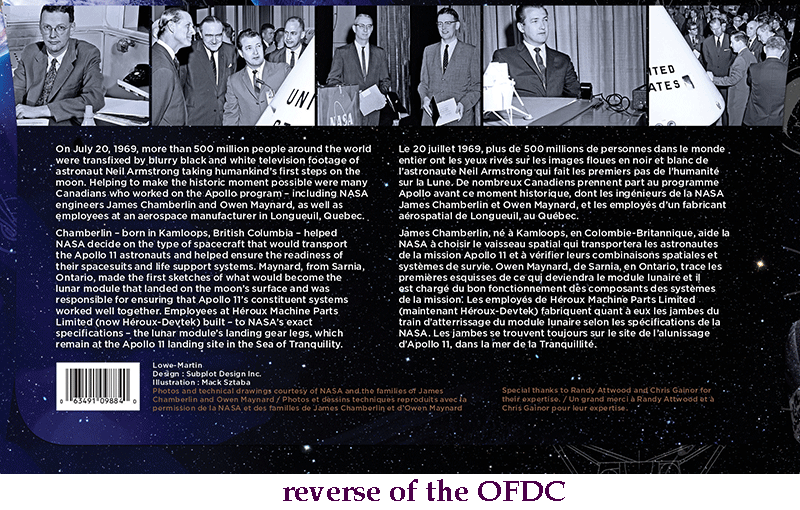
 Les premières jambes à se tenir sur la Lune n’étaient pas celles de Neil Armstrong – elles étaient confectionnées par Héroux Machine Parts de Longueuil, au Québec. Maintenant nommée Héroux-Devtek, l’entreprise a construit les jambes du train d’atterrissage, semblables à des pattes d’araignée, selon les spécifications de la NASA. Elles étaient fixées à la plateforme de lancement qui a permis à Neil Armstrong et à Buzz Aldrin de quitter la Lune pour rejoindre le module de commande principal. Les jambes se trouvent toujours sur le site de l’alunissage d’Apollo 11, dans la mer de la Tranquillité.
Les premières jambes à se tenir sur la Lune n’étaient pas celles de Neil Armstrong – elles étaient confectionnées par Héroux Machine Parts de Longueuil, au Québec. Maintenant nommée Héroux-Devtek, l’entreprise a construit les jambes du train d’atterrissage, semblables à des pattes d’araignée, selon les spécifications de la NASA. Elles étaient fixées à la plateforme de lancement qui a permis à Neil Armstrong et à Buzz Aldrin de quitter la Lune pour rejoindre le module de commande principal. Les jambes se trouvent toujours sur le site de l’alunissage d’Apollo 11, dans la mer de la Tranquillité.
 Australia Post is releasing a commemorative stamp to celebrate 50 years of the principle of equal pay for equal work in Australia.
Australia Post is releasing a commemorative stamp to celebrate 50 years of the principle of equal pay for equal work in Australia.
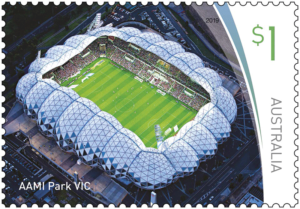 The award-winning AAMI Park was welcomed to Melbourne & Olympic Parks’ precinct in May 2010, giving Victoria its first world-class pitch for elite-level rugby league, rugby union and football codes. The 30,050-seat stadium is defined by its distinctive bio-frame design, the roof of which provides covered seating for most of a capacity crowd enjoying the spectacle on the 136 x 82 metre playing field below.
The award-winning AAMI Park was welcomed to Melbourne & Olympic Parks’ precinct in May 2010, giving Victoria its first world-class pitch for elite-level rugby league, rugby union and football codes. The 30,050-seat stadium is defined by its distinctive bio-frame design, the roof of which provides covered seating for most of a capacity crowd enjoying the spectacle on the 136 x 82 metre playing field below.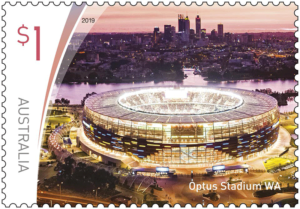 Optus Stadium was opened in Perth in January 2018, and in its first 12 months of operation attracted more than two million fans. The 60,000-seat stadium can host AFL, rugby union, rugby league, football and cricket, as well as large entertainment events. From fence to fence the pitch covers 177 x 141 metres, with 165 x 130 metres for the AFL field of play.
Optus Stadium was opened in Perth in January 2018, and in its first 12 months of operation attracted more than two million fans. The 60,000-seat stadium can host AFL, rugby union, rugby league, football and cricket, as well as large entertainment events. From fence to fence the pitch covers 177 x 141 metres, with 165 x 130 metres for the AFL field of play.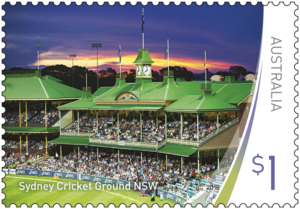 Located on the edge of the CBD, the Sydney Cricket Ground has a long and venerable history dating back to the mid-19th century. It hosted its first game of cricket in 1854, and has been home to major cricket matches since 1876. With a capacity of 48,000, in addition to hosting cricket in its various formats, it also regularly hosts AFL, rugby league and union, and football.
Located on the edge of the CBD, the Sydney Cricket Ground has a long and venerable history dating back to the mid-19th century. It hosted its first game of cricket in 1854, and has been home to major cricket matches since 1876. With a capacity of 48,000, in addition to hosting cricket in its various formats, it also regularly hosts AFL, rugby league and union, and football.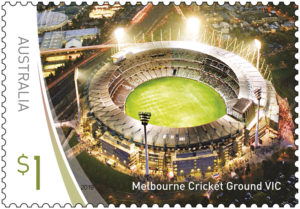 Melbourne Cricket Ground, or the MCG or ’G, as it is fondly known, is considered by many to be one of the premium stadia of the world. Built in 1853, it was the main venue for the first Olympic Games held in the Southern Hemisphere in 1956, a centrepiece for the 2006 Commonwealth Games and host to two cricket World Cups, in 1992 and 2015. Primarily a ground for AFL and cricket, with a capacity exceeding 100,000, it sits fondly in the heart of many Victorians and Australians alike.
Melbourne Cricket Ground, or the MCG or ’G, as it is fondly known, is considered by many to be one of the premium stadia of the world. Built in 1853, it was the main venue for the first Olympic Games held in the Southern Hemisphere in 1956, a centrepiece for the 2006 Commonwealth Games and host to two cricket World Cups, in 1992 and 2015. Primarily a ground for AFL and cricket, with a capacity exceeding 100,000, it sits fondly in the heart of many Victorians and Australians alike.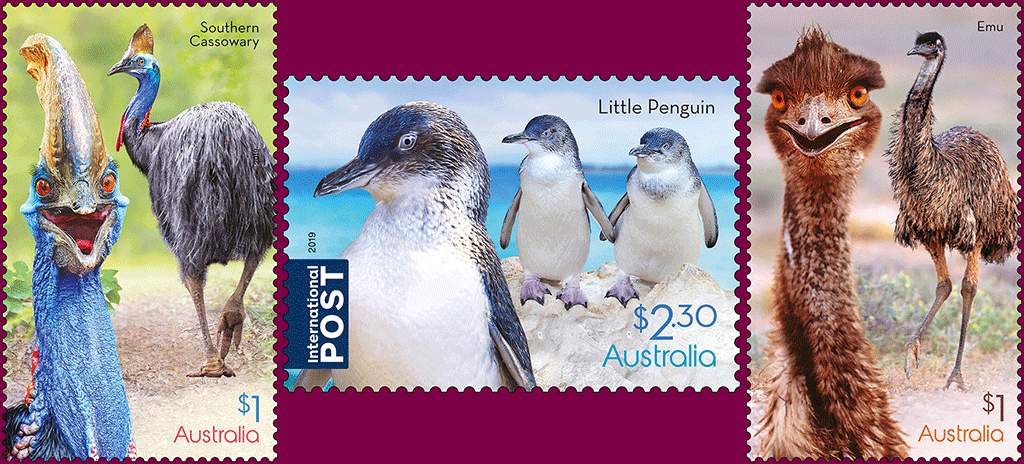
 $1 Emu (Dromaius novaehollandiae)
$1 Emu (Dromaius novaehollandiae) $1 Southern Cassowary (Casuarius casuarius)
$1 Southern Cassowary (Casuarius casuarius)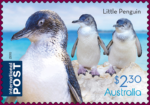 $2.30 Little Penguin (Eudyptula minor)
$2.30 Little Penguin (Eudyptula minor)
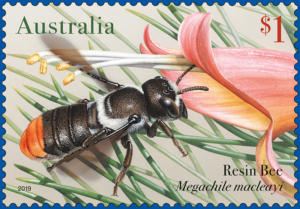 $1 Resin Bee (Megachile macleayi)
$1 Resin Bee (Megachile macleayi)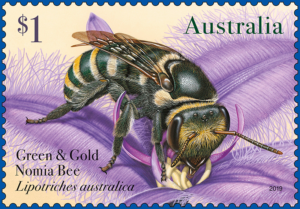 $1 Green and Gold Nomia Bee
$1 Green and Gold Nomia Bee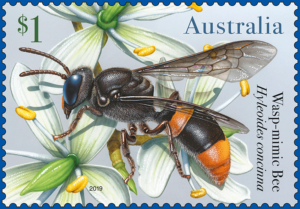 $1 Wasp-mimic Bee (Hyleoides concinna)
$1 Wasp-mimic Bee (Hyleoides concinna)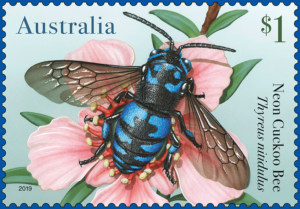 $1 Neon Cuckoo Bee (Thyreus nitidulus)
$1 Neon Cuckoo Bee (Thyreus nitidulus)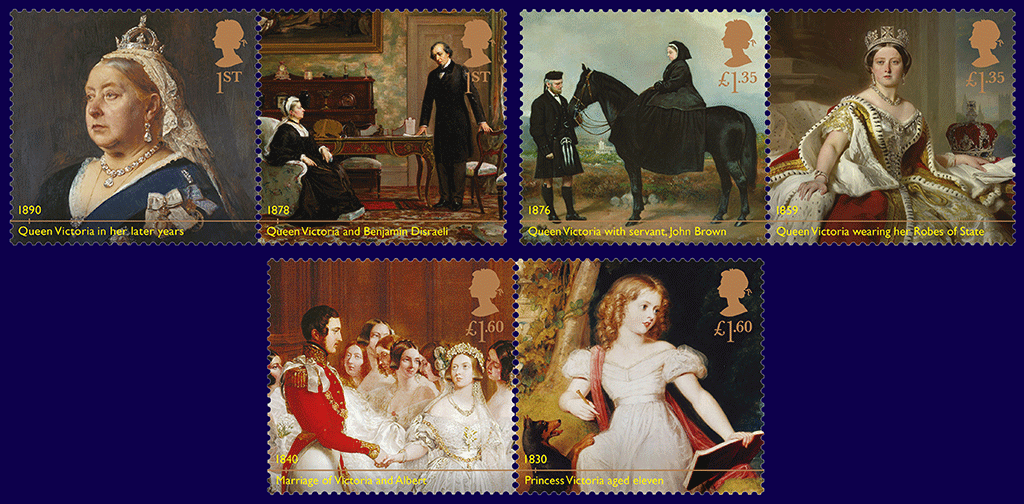
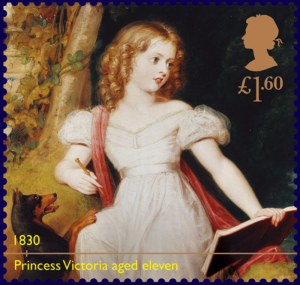 Stamps AS4583 £7.30
Stamps AS4583 £7.30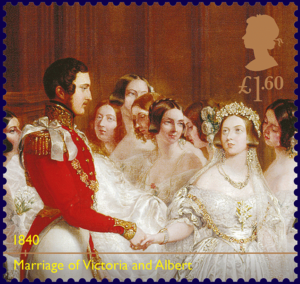 Design: Webb & Webb Design
Design: Webb & Webb Design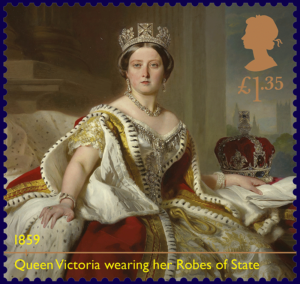 Victoria when a Girl by Richard Westall, Royal Collection Trust/© Her Majesty Queen Elizabeth II 2019
Victoria when a Girl by Richard Westall, Royal Collection Trust/© Her Majesty Queen Elizabeth II 2019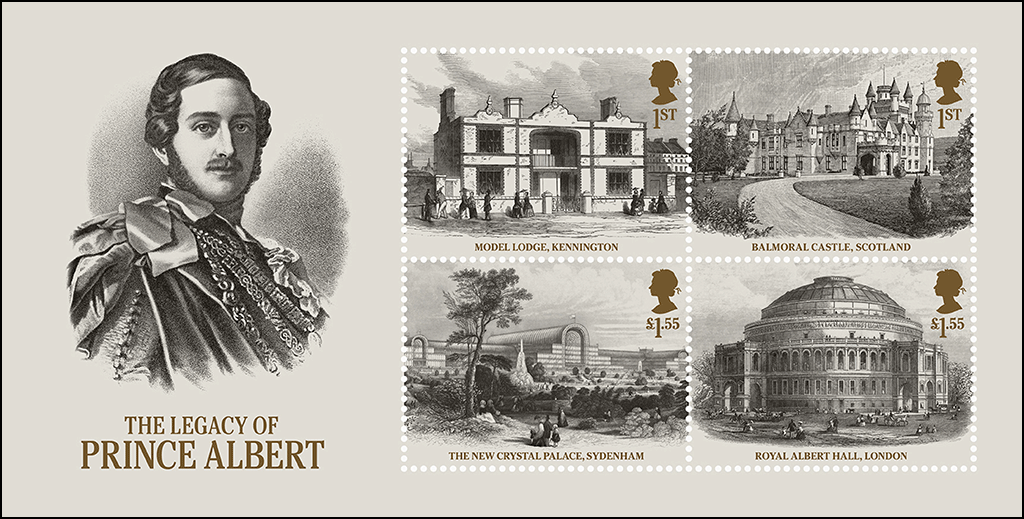
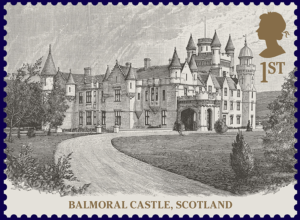 Acknowledgements: Background image – Albert Prince Consort © Hulton Fine Art Collection/Getty Images; Model Lodge, Kennington, Private Collection/© Look and Learn/Illustrated Papers Collection/Bridgeman Images; Balmoral Castle, Scotland, Private Collection/© Look and Learn/Bridgeman Images; The New Crystal Palace, Sydenham © Science & Society Picture Library/Getty Images; Royal Albert Hall, London, Private Collection/© Look and Learn/Peter Jackson Collection/Bridgeman Images
Acknowledgements: Background image – Albert Prince Consort © Hulton Fine Art Collection/Getty Images; Model Lodge, Kennington, Private Collection/© Look and Learn/Illustrated Papers Collection/Bridgeman Images; Balmoral Castle, Scotland, Private Collection/© Look and Learn/Bridgeman Images; The New Crystal Palace, Sydenham © Science & Society Picture Library/Getty Images; Royal Albert Hall, London, Private Collection/© Look and Learn/Peter Jackson Collection/Bridgeman Images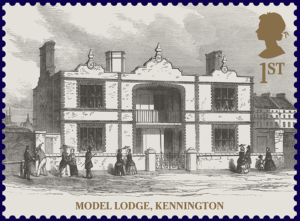 Miniature sheet size: 146mm x 74mm
Miniature sheet size: 146mm x 74mm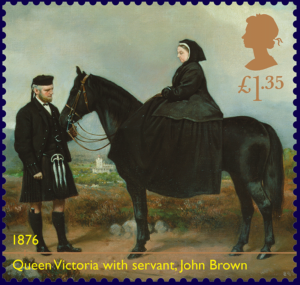 The Presentation Pack contains all six special stamps plus the Legacy of Prince Albert miniature sheet in a separate carrier. The pack includes an illustrated biography of Queen Victoria reflecting on her life on one side and her long period of mourning following the death of Prince Albert on the other.
The Presentation Pack contains all six special stamps plus the Legacy of Prince Albert miniature sheet in a separate carrier. The pack includes an illustrated biography of Queen Victoria reflecting on her life on one side and her long period of mourning following the death of Prince Albert on the other.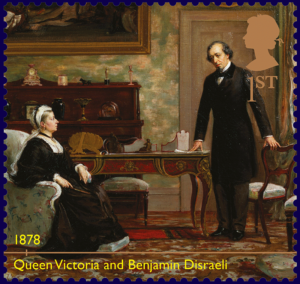
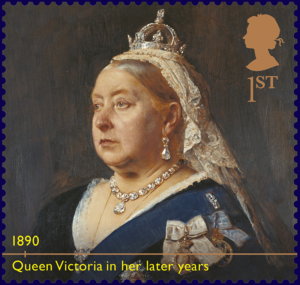
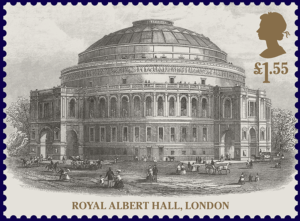
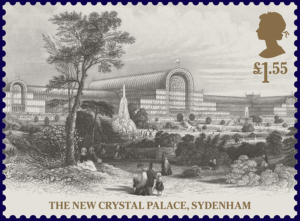
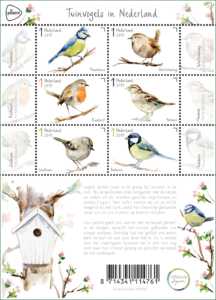 The Hague, 23 May 2018 – On 20 May, PostNL issued a new stamp sheet: Garden Birds in the Netherlands. Illustrations of 6 different garden birds adorn this sheet. Michelle Dujardin provided the illustrations, art director Yvonne Warmerdam was responsible for the stamp design.
The Hague, 23 May 2018 – On 20 May, PostNL issued a new stamp sheet: Garden Birds in the Netherlands. Illustrations of 6 different garden birds adorn this sheet. Michelle Dujardin provided the illustrations, art director Yvonne Warmerdam was responsible for the stamp design.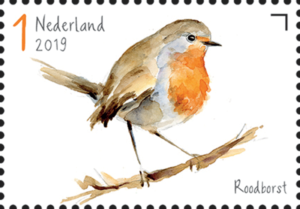 sparrow is sitting on the ground. The illustrations by Michelle Dujardin have its characteristic minimalist style: realistic, with a slight abstract-impressionistic touch. Michelle: “I have chosen 6 common garden birds. They are birds of which everyone at least knows the name. Last summer I saw a golden rooster here in the garden. Striking, because normally you don’t see them often in the west. I have a weakness for the shape of this type of bird, which also includes the wren. Real balls that actually still resemble the egg from which they crawled. On the stamps I have depicted them the way I prefer them. As if every bird is alive, has a soul and could fly up
sparrow is sitting on the ground. The illustrations by Michelle Dujardin have its characteristic minimalist style: realistic, with a slight abstract-impressionistic touch. Michelle: “I have chosen 6 common garden birds. They are birds of which everyone at least knows the name. Last summer I saw a golden rooster here in the garden. Striking, because normally you don’t see them often in the west. I have a weakness for the shape of this type of bird, which also includes the wren. Real balls that actually still resemble the egg from which they crawled. On the stamps I have depicted them the way I prefer them. As if every bird is alive, has a soul and could fly up 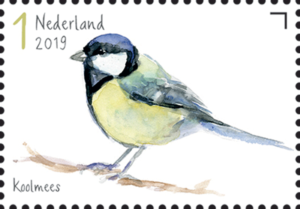 like that.”
like that.”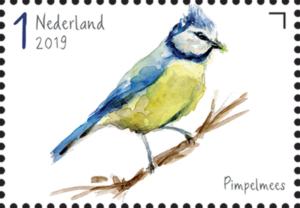 The Tuinvogels stamp sheet in the Netherlands has 6 stamps in 6 different designs, with value designation 1, intended for mail up to 20 grams with a destination within the Netherlands. The stamps have been available since May 20 at the post office in the Bruna stores and via the website. The stamps can also be ordered by telephone from Collect Club customer service on telephone number 088 – 868 99 00. The period of validity is indefinite.
The Tuinvogels stamp sheet in the Netherlands has 6 stamps in 6 different designs, with value designation 1, intended for mail up to 20 grams with a destination within the Netherlands. The stamps have been available since May 20 at the post office in the Bruna stores and via the website. The stamps can also be ordered by telephone from Collect Club customer service on telephone number 088 – 868 99 00. The period of validity is indefinite. 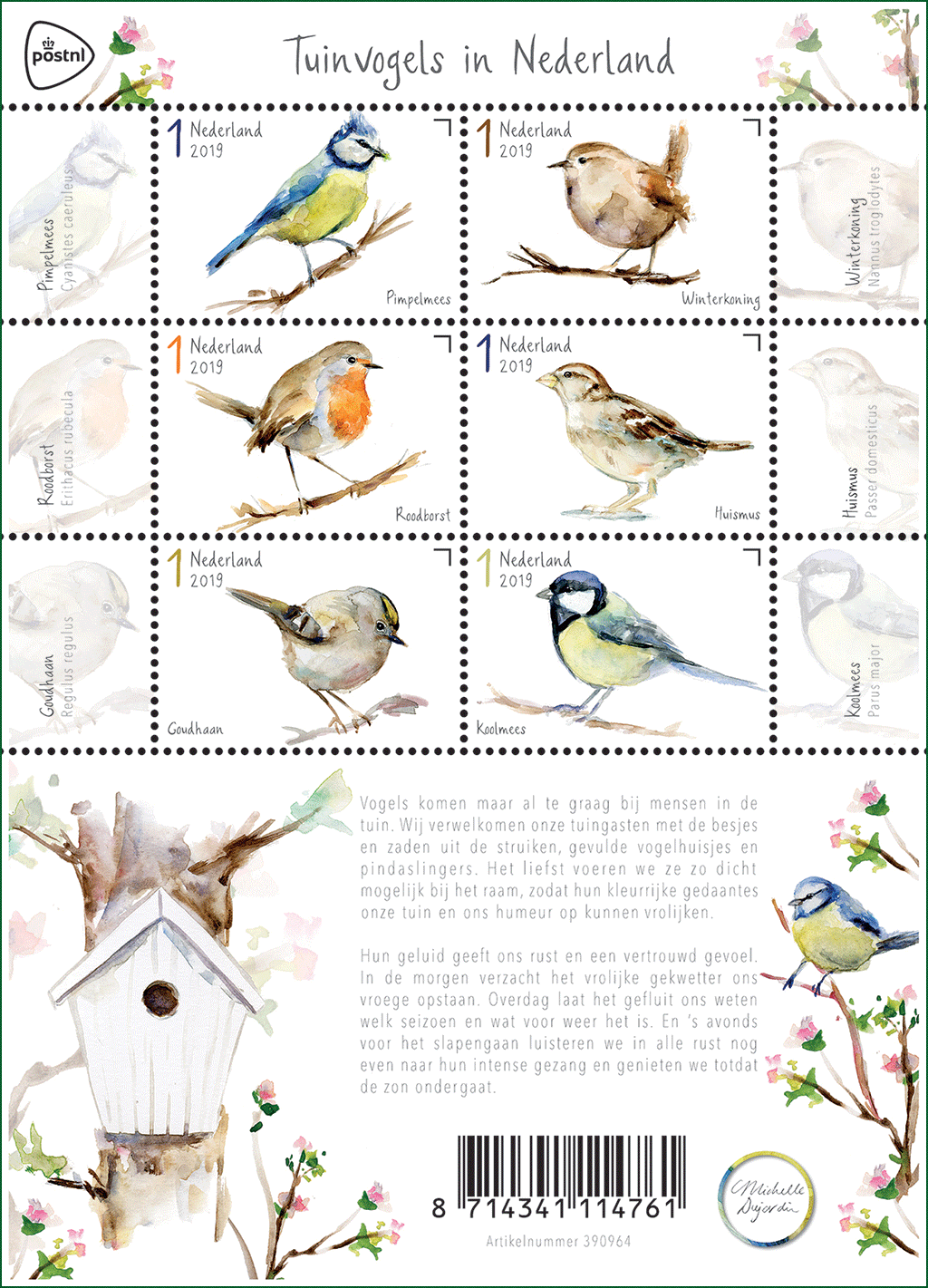
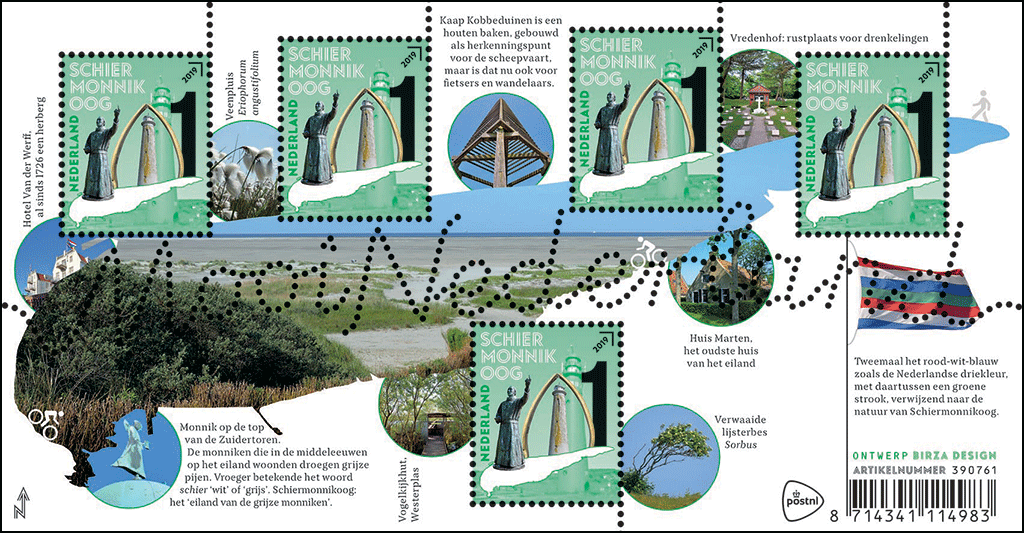
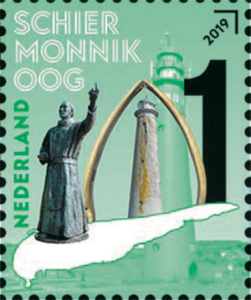 In the design of ‘Beautiful Netherlands 2019: Schermonnikoog’, the island shape plays the leading role. This is reflected in the map of Schiermonnikoog, which the designers have positioned in miniature on the stamps and in large on the stamp sheetlet. The stamps show recognisable images of the island: the current lighthouse (North Tower, Noordertoren), the former lighthouse (South Tower, Zuidertoren), the lower jaw of a blue whale and the statue of theSchiere Monnik (literally ‘the Grey Monk’), both of which are in the centre of the village. The typical shape of the island is also reflected in the design in other ways. For example, the font used for the captions is a ‘stencil font’, made up of elements that are separate from each other.
In the design of ‘Beautiful Netherlands 2019: Schermonnikoog’, the island shape plays the leading role. This is reflected in the map of Schiermonnikoog, which the designers have positioned in miniature on the stamps and in large on the stamp sheetlet. The stamps show recognisable images of the island: the current lighthouse (North Tower, Noordertoren), the former lighthouse (South Tower, Zuidertoren), the lower jaw of a blue whale and the statue of theSchiere Monnik (literally ‘the Grey Monk’), both of which are in the centre of the village. The typical shape of the island is also reflected in the design in other ways. For example, the font used for the captions is a ‘stencil font’, made up of elements that are separate from each other.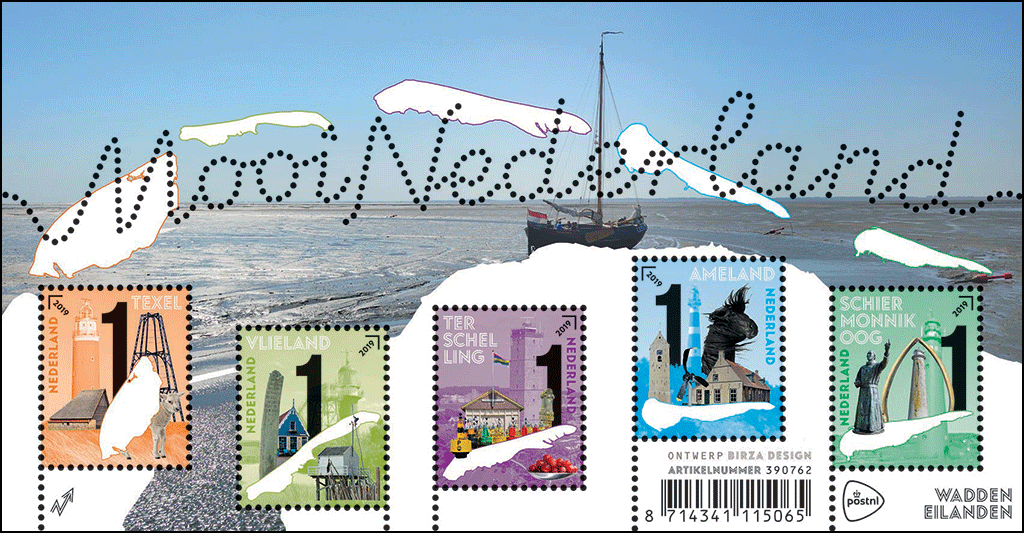
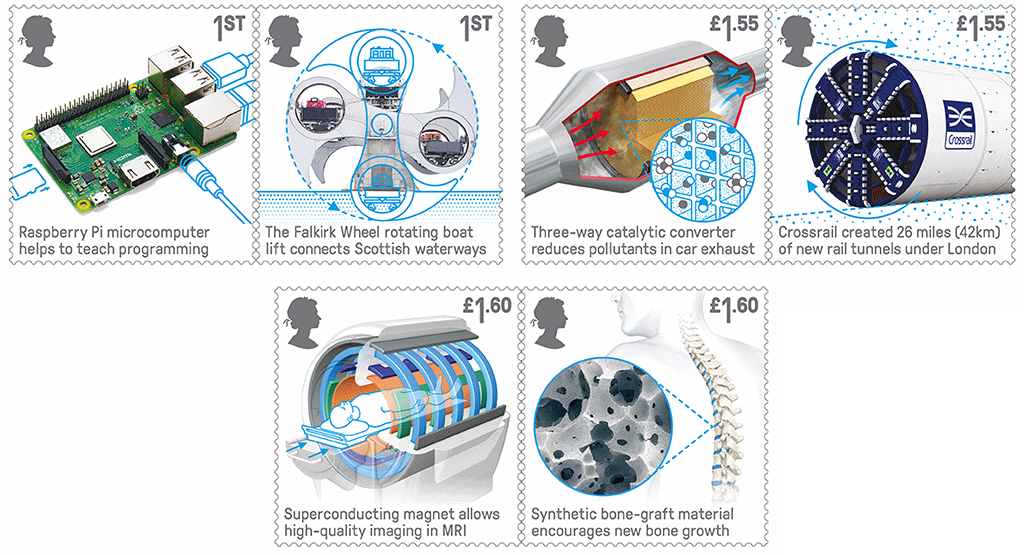
 Royal Mail has revealed 10 new Special Stamps to mark Britain’s long and proud history of engineering excellence.
Royal Mail has revealed 10 new Special Stamps to mark Britain’s long and proud history of engineering excellence. A collaboration of British engineers and architects produced the world’s first and only rotating boat lift, The Falkirk Wheel, joining two major Scottish canals for the first time in 70 years with a phenomenally beautiful structure.
A collaboration of British engineers and architects produced the world’s first and only rotating boat lift, The Falkirk Wheel, joining two major Scottish canals for the first time in 70 years with a phenomenally beautiful structure. prevent some 20 million tonnes of pollutants from entering the atmosphere, helping to make the world cleaner and healthier.”
prevent some 20 million tonnes of pollutants from entering the atmosphere, helping to make the world cleaner and healthier.” The team at Queen Mary University of London led by Dr Karin Hing, engineered materials that encourage bone growth when used in complex orthopaedic surgeries and have improved the outcomes for hundreds of thousands of patients worldwide.
The team at Queen Mary University of London led by Dr Karin Hing, engineered materials that encourage bone growth when used in complex orthopaedic surgeries and have improved the outcomes for hundreds of thousands of patients worldwide. people’s lives, but this would not have been possible without multidisciplinary collaboration. Having our engineering of synthetic bone grafts celebrated on a stamp like the Marvel Comics and the Harry Potter books might even impress my kids.”
people’s lives, but this would not have been possible without multidisciplinary collaboration. Having our engineering of synthetic bone grafts celebrated on a stamp like the Marvel Comics and the Harry Potter books might even impress my kids.”
 Some of the innovations celebrated have won the MacRobert Award, bestowed by the Royal Academy of Engineering – the UK’s most prestigious and longest running award for engineering excellence. The award marks its 50th birthday this year.Dr Dame Sue Ion DBE FREng FRS, Chair of Judges for the Royal Academy of Engineering MacRobert Award, said: “The UK is a global engineering powerhouse with many world firsts developed here that have both benefitted our economy and helped to transform people’s lives for the better. This wonderful new set of Royal Mail stamps perfectly encapsulates the technical and commercial achievements made by British engineers over the last 50 years, from the Harrier jump jet to Raspberry Pi. These great British engineering innovations – several of which have won the MacRobert Award, the UK’s biggest prize for engineering innovation – represent an amazing foundation from which to develop exciting technologies for the future.”Philip Parker, Royal Mail, said: “British innovation in engineering is world renowned. This stamp issue proudly celebrates the projects and inventions which showcase this, as well as demonstrating the extraordinary range of disciplines that British engineers excel in.”
Some of the innovations celebrated have won the MacRobert Award, bestowed by the Royal Academy of Engineering – the UK’s most prestigious and longest running award for engineering excellence. The award marks its 50th birthday this year.Dr Dame Sue Ion DBE FREng FRS, Chair of Judges for the Royal Academy of Engineering MacRobert Award, said: “The UK is a global engineering powerhouse with many world firsts developed here that have both benefitted our economy and helped to transform people’s lives for the better. This wonderful new set of Royal Mail stamps perfectly encapsulates the technical and commercial achievements made by British engineers over the last 50 years, from the Harrier jump jet to Raspberry Pi. These great British engineering innovations – several of which have won the MacRobert Award, the UK’s biggest prize for engineering innovation – represent an amazing foundation from which to develop exciting technologies for the future.”Philip Parker, Royal Mail, said: “British innovation in engineering is world renowned. This stamp issue proudly celebrates the projects and inventions which showcase this, as well as demonstrating the extraordinary range of disciplines that British engineers excel in.”
 The Hawker Siddeley Harrier was developed from a unique experimental aircraft known as the P 1127, which was capable of taking off and landing vertically. In 1962, British, US and German armed forces procured nine of these aircraft to form a Tri-Partite Evaluation Squadron at RAF West Raynham. Now called Kestrels, these aircraft could take off and land using paved runways, semi-prepared sites in clearings in woods and other confined
The Hawker Siddeley Harrier was developed from a unique experimental aircraft known as the P 1127, which was capable of taking off and landing vertically. In 1962, British, US and German armed forces procured nine of these aircraft to form a Tri-Partite Evaluation Squadron at RAF West Raynham. Now called Kestrels, these aircraft could take off and land using paved runways, semi-prepared sites in clearings in woods and other confined  spaces.
spaces. extremely effective ground attack. They could drop precision-guided weapons and operate in poor weather using the latest radar, infrared and optical devices. Because of their remarkable take-off ability, they became known as Harrier Jump Jets.
extremely effective ground attack. They could drop precision-guided weapons and operate in poor weather using the latest radar, infrared and optical devices. Because of their remarkable take-off ability, they became known as Harrier Jump Jets. Academy of Engineering in 1969. Photographer Richard Cook captured a Harrier GR3 especially for the stamps.
Academy of Engineering in 1969. Photographer Richard Cook captured a Harrier GR3 especially for the stamps.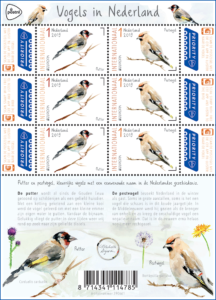 PostNL has released new stamps on April 23 for international destinations, with illustrations of the putter and the plague bird. These two colorful birds have an age-old name in Dutch history. Both illustrations were made by Michelle Dujardin, the stamp design by art director Yvonne Warmerdam.
PostNL has released new stamps on April 23 for international destinations, with illustrations of the putter and the plague bird. These two colorful birds have an age-old name in Dutch history. Both illustrations were made by Michelle Dujardin, the stamp design by art director Yvonne Warmerdam.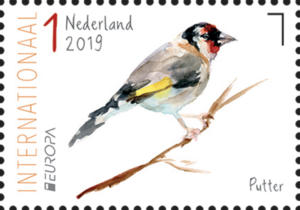 have its characteristic minimalist style: realistic, with a slight abstract-impressionistic touch. Michelle: “The putter and the plague bird are consciously set against each other. They fit well together, all 2 start with a p and both have a striking nickname. And they also form a beautiful contradiction – one loved, the other feared. While both are very beautiful birds. ”
have its characteristic minimalist style: realistic, with a slight abstract-impressionistic touch. Michelle: “The putter and the plague bird are consciously set against each other. They fit well together, all 2 start with a p and both have a striking nickname. And they also form a beautiful contradiction – one loved, the other feared. While both are very beautiful birds. ”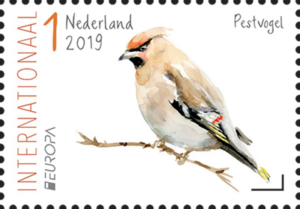 As a follow-up to the issue for PostEurop, PostNL will issue a second stamp sheet on 20 May 2019: Garden Birds in the Netherlands. On this issue there are illustrations of 6 garden birds: blue tit, winter king, robin, house sparrow, golden rooster and great tit. Michelle Dujardin also provided the illustrations for this issue and Yvonne Warmerdam the design.
As a follow-up to the issue for PostEurop, PostNL will issue a second stamp sheet on 20 May 2019: Garden Birds in the Netherlands. On this issue there are illustrations of 6 garden birds: blue tit, winter king, robin, house sparrow, golden rooster and great tit. Michelle Dujardin also provided the illustrations for this issue and Yvonne Warmerdam the design.

